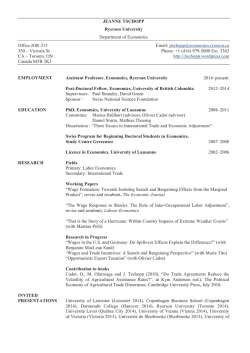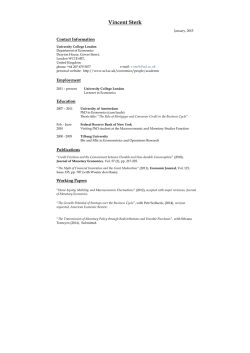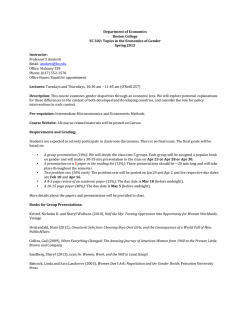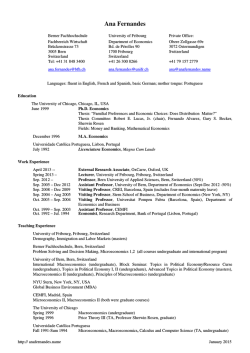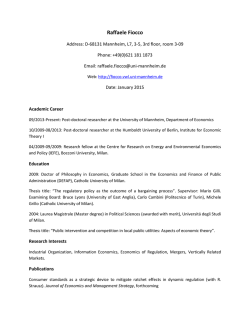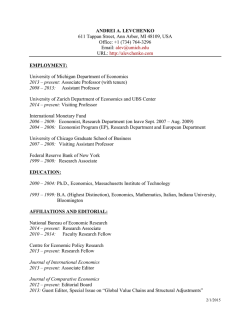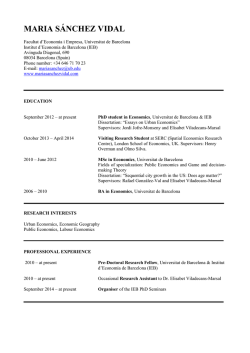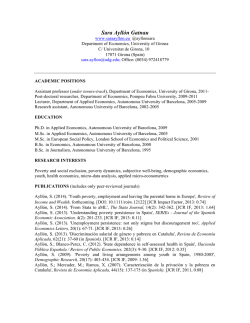
The Political Economy of Economic Development Spring 2015
The Political Economy of Economic Development Spring 2015 Economics 2392 Class Location: Sever 110 Version: Final Instructor: Melissa Dell M-24, Littauer Center Department of Economics [email protected] Office Hours: Fridays 4:30 – 5:30 PM Teaching Assistant: Sara Lowes [email protected] Office hours: TBA Prerequisites: The course is designed for PhD candidates in Economics, Business Economics, and Political Economy and Government (PEG), and any students in these programs may enroll. Qualified undergraduates, masters students, and PhD students from other programs may also enroll with the permission of the instructor if, and only if, they meet the following pre-requisites: 1) satisfactory completion or concurrent enrollment in Economics 2010a/2010b or 2020a/2020b; 2) satisfactory completion of Economics 2110, 1123, or 1126; and 3) satisfactory completion of Computer Science 50 OR significant programming experience through a research assistantship. No exceptions will be made to these pre-requisites. Students not meeting the pre-requisites are welcome to audit the course. Material: Readings denoted by ** will be covered in depth in the lectures. Other readings may also be discussed in lecture, but not in as much detail. Meetings: Mondays 1:00 – 2:30 and Wednesdays 1:00 – 2:15. We adjourn 15 minutes early on Wednesdays so that everyone is able to attend the Harvard-MIT development workshop, which is held at MIT on Weds, 2:45 – 4:00. All PhD students who plan to take generals in development economics should be attending the workshop whenever possible. Requirements: There are four types of assignments: problem sets (25% of the final grade), mock referee reports (25% of the final grade), a discussion of a study on the syllabus (25% of the final grade), and a 3-5 page research paper prospectus (25% of the final grade). The assignments have been carefully designed to build skills that are used on a regularly basis by academic researchers. There will be five problem sets. Some will focus on setting up and solving models that are typical of those used in the political economy literature, and some will emphasize developing basic programming skills needed to conduct empirical research. There will be two referee reports, written for any two papers of your choosing on the syllabus. Please do not write a referee report on any of the books. You will also write a referee report providing feedback on a classmate’s research prospectus. The discussion is designed to simulate the types of discussions that are often given at NBER summer institutes and other conferences. The discussion requires a 15-20 minute class presentation about a paper on the syllabus. Signup will occur after the end of the shopping period. There are important differences between a good discussion and a good referee report, and these distinctions will be explained in lecture. The research prospectus is a 3-5 page (maximum) document that outlines an idea for an empirical research paper. It should discuss the motivation, the identification strategy, the data to be used, and the relation to the existing literature. The discussion of the existing literature should be at most one page, and attention should be directed primarily towards describing why the question is novel and important, relating the question to available data sources, and carefully outlining an identification strategy. Students should select the most compelling topic that interests them, without worry for whether the data can be obtained by the end of the course, as there is no penalty for not yet having accessed the data if a clear strategy is presented for obtaining them. During the last course of the semester, we will divide into small groups of 3-4 (assuming >4 students are enrolled), and each person will give a 20 minute presentation to others in their group. Everyone will provide written feedback, in the form of a short referee report, for others in their group. Deadlines: Late problem sets will not be accepted, but the lowest problem set grade will be dropped. The first referee report is due by the last class before the spring recess (March 11), and the second is due by the last class of the semester (April 29), no exceptions, but either may be submitted at any earlier point in the semester. Signup for discussions will occur at the close of the shopping period. The research prospectus is due by May 6. No work will be accepted after this date. Readings: Most readings will be available for download on the course website. Collaboration: Collaboration on problem sets is permitted, but each student must hand in a separate problem set and list the names of everyone he or she collaborated with at the top of the problem set. Students may informally discuss their critiques of the papers they are referring, but should write their own referee report. Students are encouraged to seek feedback on their discussion and their research paper prospectus from other classmates. Schedule DATE TOPIC Introduction and the history of thought 26-Jan Introduction: cross-country and sub-national patterns of economic development 28-Jan The history of thought on political economy and economic development Deep determinants of economic development 2-Feb Historical institutions and long-run development 4-Feb State capacity and economic development 9-Feb Persistence Democratic and non-democratic politics 11-Feb Collective choice and static voting models 18-Feb Dynamic voting and distributive policies 23-Feb Voting: empirical evidence 25-Feb Democracy, inequality, and economic growth 2-Mar Politics in non-democratic countries 4-Mar Democratization Structural change and industrial policy 9-Mar Structural change 11-Mar Misallocation 23-Mar Industrial policy Reforms and economic development 25-Mar Land reform 30-Mar Fiscal reform 1-Apr Decentralization Corruption 6-Apr Patterns of corruption 8-Apr Fighting corruption Organized crime and conflict 13-Apr Organized crime, the state, and development 15-Apr Conflict International political economy 20-Apr Foreign intervention 22-Apr Foreign aid 27-Apr Trade Student presentations 29-Apr Small group presentations of research prospectuses 1-May 6-May DUE Problem set 1 Problem set 2 Problem set 3 Referee report 1 Problem set 4 Problem set 5 Referee report 2 Feedback on other students' presentations Research prospectus due 1. Introduction: cross-country and sub-national patterns of economic development This lecture presents the basic patterns in the spatial distribution of income and stability, as well as providing a brief overview of the main explanations that have been given for spatial income differences. The lecture will also summarize the topics and methodologies that will be covered in the course and outline the course requirements. ** Pritchett, L. (1997). Divergence, big time. The Journal of Economic Perspectives, 317. ** Gennaioli, Nicola, Rafael LaPorta, Florencio Lopez-de-Silanes, and Andrei Shleifer. (2014). Growth in Regions, Journal of Economic Growth 19, no. 3: 259-309. **Acemoglu, D., & Dell, M. (2010). Productivity Differences between and within Countries. American Economic Journal: Macroeconomics, 2(1), 169-88. ** Fearon, J. and Laitin, D. (2012). “How Persistent Is Armed Conflict?” Paper prepared for the 2012 Annual Meetings of the American Political Science Association. https://web.stanford.edu/group/fearon-research/cgi-bin/wordpress/wpcontent/uploads/2013/10/persistenceofarmedconflict.pdf Acemogu, D. (2010). “Theory, General Equilibrium, Political Economy and Empirics in Development Economics,” Journal of Economic Perspectives, 24(3), pp. 17-32. Acemoglu, Daron, Johnson, Simon and Robinson, James (2006) “Institutions as a Fundamental Cause of Long-Run Growth” in Handbook of Economic Growth, Aghion, Philippe and Durlauf, Steven, eds. Amsterdam; North-Holland. Acemoglu, D., Robinson, J. A. (2012). Why nations fail: the origins of power, prosperity, and poverty (Vol. 4). New York: Crown Business. Nunn N. (2012). “Culture and the Historical Process.” Economic History of Developing Regions. 2012;27, pp.108-126. Diamond, J. M. (1998). Guns, germs and steel: a short history of everybody for the last 13,000 years. Random House. Dell, M., Jones, B. F., & Olken, B. A. (2012). Temperature shocks and economic growth: Evidence from the last half century. American Economic Journal: Macroeconomics, 4(3), 66-95. Dell, M., Jones, B., & Olken, B. (2009). “Temperature and Income: Reconciling New Cross-Sectional and Panel Estimates.” In American Economic Review Papers and Proceedings (Vol. 99, No. 2, pp. 198-204). 2. The history of thought on political economy and economic development The way we conduct modern research on the political economy of development is only one possibility in a large space of how research could and has been conducted. This lecture will examine how and why the methodological pendulum swung between the 1940s and 1990s, focusing on the perspectives of three Nobel Prizing winning economists: Solow, Krugman, and Stiglitz. It will also provide an overview of key methodological development since the 90s, which will be the focus of much of the rest of the course. Please be sure to read the starred readings before class and come prepared to discuss your thoughts and reactions to them. **Solow, R (1997). “How Did Economics Get that Way and What Way Did It Get?” Daedalus, Vol. 126(1). http://www.jstor.org/stable/20027408?seq=1#page_scan_tab_contents **Krugman, P (1994). “The Fall and Rise of Development Economics,” mimeo. http://rrojasdatabank.info/krugman1994.pdf **Stiglitz, J (2001). “An Agenda for the New Development Economics,” UNRISD Conference Proceedsings, http://www.rrojasdatabank.info/stiglitz.pdf. Stiglitz, J (1997). “An Agenda for Development in the Twenty-First Century” Annual World Bank Conference on Development Economics. J.E. Stiglitz and B. Pleskovic (eds.). The World Bank. https://www0.gsb.columbia.edu/faculty/jstiglitz/download/papers/1998_Agenda_for_Dev elopment.pdf Murphy, K. M., Shleifer, A., Vishny, RW (1989). Industrialization and the Big Push. The Journal of Political Economy, 97(5), 1003-1026. 3. Historical institutions and long-run development The next several lectures focus on longer-run institutional determinants of economic prosperity. This lecture will also introduce two commonly used methodologies: instrumental variables and spatial regression discontinuity. **Acemoglu, D., Johnson, S., & Robinson, J. A. (2002). “Reversal of fortune: Geography and institutions in the making of the modern world income distribution.” Quarterly journal of economics, 1231-1294. **Dell, M. (2010). “The persistent effects of Peru's mining mita.” Econometrica,78(6), 1863-1903. **Nunn N. The Long Term Effects of Africa's Slave Trades. Quarterly Journal of Economics. 2008;123(1):139-176. Nunn, N., & Puga, D. (2012). Ruggedness: The blessing of bad geography in Africa. Review of Economics and Statistics, 94(1), 20-36. Nunn, Nathan, and Leonard Wantchekon. 2011. "The Slave Trade and the Origins of Mistrust in Africa." American Economic Review, 101(7): 3221-52. Iyer, L., & Banerjee, A. (2005). History, Institutions, and Economic Performance: The Legacy of Colonial Land Tenure Systems in India. American Economic Review, 95(3), 1190-1213. La Porta R, Lopez-de-Silanes F, Shleifer A, Vishny R. (1998). Law and finance. Journal of Political Economy. Engerman, S. L., & Sokoloff, K. L. (2002). “Factor endowments, inequality, and paths of development among new world economics” (No. w9259). National Bureau of Economic Research. Feyrer, J., & Sacerdote, B. (2009). Colonialism and modern income: islands as natural experiments. The Review of Economics and Statistics, 91(2), 245-262. Huillery, Elise. "History matters: The long-term impact of colonial public investments in French West Africa." American Economic Journal: Applied Economics (2009): 176-215. Acemoglu, D., Johnson, S., & Robinson, J. A (2001). “The Colonial Origins of Comparative Development: An Empirical Investigation.” The American Economic Review, 91(5), 1369-1401. Acemoglu, Daron, Simon Johnson and James Robinson (2006) “Institutions as a Fundamental Cause of Long-Run Growth” in Philippe Aghion and Steven Durlauf eds. Handbook of Economic Growth, Amsterdam; North-Holland. Albouy, D. Y. (2012). The colonial origins of comparative development: an empirical investigation: comment. The American Economic Review, 102(6), 3059-3076. Acemoglu, D., Johnson, S., & Robinson, J. A. (2012). The colonial origins of comparative development: An empirical investigation: Reply. The American Economic Review, 102(6), 3077-3110. 4. State Capacity and Economic Development There will be a half hour lecture at the usual time about state capacity and economic development. In lieu of the normal full length lecture, everyone is strongly encouraged to attend the Development Workshop (held at MIT this semester), where I will present a paper on state capacity and long-run development in Vietnam. For those who cannot attend due to scheduling constraints, slides and a copy of the paper will be posted on the course website. **Michalopoulos, S., & Papaioannou, E. (2013). Pre‐Colonial Ethnic Institutions and Contemporary African Development. Econometrica, 81(1), 113-152. **Michalopoulos, S., & Papaioannou, E (2014). National Institutions and Subnational Development in Africa. The Quarterly Journal of Economics, 129(1), 151-213. Acemoglu, D (2005). “Politics and Economics in Weak and Strong States”, Journal of Monetary Economics, 52, 1199-1226. Acemoglu, D., García-Jimeno, C., & Robinson, J. A. (2014). “State Capacity and Economic Development: A Network Approach” (No. w19813). National Bureau of Economic Research. Besley, T. and T. Persson (2009). "The Origins of State Capacity: Property Rights, Taxation, and Politics." American Economic Review, 99(4): 1218-44. 5. Persistence This lecture will examine evidence about path dependence, persistence, and change. **Bleakley, H., & Lin, J. (2012). “Portage and path dependence.” The Quarterly Journal of Economics, 127(2), 587. **Dell, M. (2015). “Path Dependence in Development: Evidence from the Mexican Revolution.” Mimeo. Banerjee, A. & Duflo E. (2014). “Under the Thumb of History? Political Institutions and the Scope for Action,” Annual Review of Economics, Vol. 6: 951 -971. Robinson, J. A., & Acemoglu, D. (2008). “Persistence of Power, Elites and Institutions.” American Economic Review, 98(1). Dippel, C. (2014). "Forced Coexistence and Economic Development: Evidence from Native American Reservations," forthcoming Econometrica. Bleakley, H., & Ferrie, J. (2014). “Land Openings on the Georgia Frontier and the Coase Theorem in the Short- and Long-Runs” mimeo. David, P. A. (1985). Clio and the Economics of QWERTY. The American Economic Review, 332-337. 6. Collective choice and Static Voting Models We will spend a lecture reviewing collective choice and static voting models. While there could be an entire course or series of courses focusing only on collective choice, our main objective is to become familiar with the basics that come up frequently in the political economy of development literature. **Person, Torsten and Guido Tabellini (2000). Political Economics: Explaining Economic Policy, Cambridge; The MIT Press, Chapters 2, 3, 4, and 6. **Maskin, E. “The Arrow Impossibility Theorem: Where Do We Go From Here?” https://www.sss.ias.edu/files/papers/econpaper93.pdf 7. Dynamic voting and distributive policies This lecture provides an introduction to voting over distributive policies in dynamic models. The first two readings are a review of dynamic games. If you have not worked with dynamic games recently, please be sure to carefully review these before the lecture. ** Fudenberg, Drew and Jean Tirole (1991) Game Theory, Cambridge; MIT Press. Chapters 4, 5 and 13. If you have not solved dynamic games lately, please be sure to review this before Lecture 7. **Acemoglu, D. “A review of Dynamic Games” (see course website). ** Alesina, Alberto and Rodrik, Dani (1994) “Distributive Politics and Economic Growth,” Quarterly Journal of Economics, 109, 465-490. ** Hassler Jon, Mora, Sevi, Storlesseten, Kjandetil and Zilibotti, Fabrizio (2003). “Survival of the Welfare State,” American Economic Review, 93, 87-112. Acemoglu, Daron, Egorov, Georgy and Sonin, Konstantin (2008). “Coalition Formation in Nondemocratic Societies.” Review of Economic Studies. Roberts, Kevin (2005). “Dynamic Voting in Clubs,” mimeo. http://sticerd.lse.ac.uk/dps/te/te367.pdf. 8. Voting: empirical evidence This lecture will examine empirical questions about voting, in particular whether policies represent the median voter and how candidates can buy votes. The first article in the reading list is a seminal RD paper, and we will spent part of the lecture discussing this methodology. ** Lee, D. S., Moretti, E., & Butler, M. J. (2004). Do voters affect or elect policies? Evidence from the US House. The Quarterly Journal of Economics, 807-859. ** Chattopadhyay, Raghabendra and Duflo, Esther (2004) “Women as Policy Makers: Evidence from an India-wide Randomized Policy Experiment”, Econometrica, Vol. 72, No. 5, pp. 1409-1443. ** Jones, Benjamin F. and Olken, Benjamin A. (2005) “Do Leaders Matter? National Leadership and Growth Since World War II,” Quarterly Journal of Economics, 120, 835864 ** Fujiwara, Thomas, "Voting Technology, Political Responsiveness, and Infant Health: Evidence from Brazil." Forthcoming Econometrica. Larreguy, Horacio (2012) “Monitoring Political Brokers: Evidence from Clientelistic Networks in Mexico” Mimeo. Baland, Jean Marie and James A. Robinson (2008) “Land and Power: Theory and Evidence from Chile”, American Economic Review 98 , no. 5 (2008): 1737–65 Finan, Frederico and Laura Schecter (2012) "Vote-Buying and Reciprocity", Econometrica, 80(2): 863-881. Pande, Rohini, (2003) “Can Mandated Political Representation Increase Policy Influence for Disadvantaged Minorities”, American Economic Review 93 (4), pp 1132-1151. Vicente, Pedro (2013), "Is Vote Buying Effective? Evidence from a Field Experiment in West Africa?" Economic Journal. Callen, Michael and James Long (2011) "Institutional Corruption and Election Fraud: Evidence from a Field Experiment in Afghanistan," Mimeo Hainmueller J, & Snyder J. “Assessing the External Validity of Election RD Estimates: An Investigation of the Incumbency Advantage.” Journal of Politics (forthcoming). 9. Democracy, inequality, and economic growth This lecture will examine evidence on the relationship between democracy and inequality, and between inequality and economic growth. ** Acemoglu, D., Naidu, S., Restrepo, P., & Robinson, J. A. (2013). Democracy, redistribution and inequality (No. w19746). National Bureau of Economic Research. ** Engerman, S. L., & Sokoloff, K. L. (2002). “Factor endowments, inequality, and paths of development among new world economics” (No. w9259). National Bureau of Economic Research. ** Dornbusch, R., & Edwards, S. (1991). The macroeconomics of populism. In The macroeconomics of populism in Latin America (pp. 7-13). University of Chicago Press. http://www.nber.org/chapters/c8295.pdf ** Benabou, Roland. "Inequality and growth." NBER Macroeconomics Annual 1996, Volume 11. MIT Press, 1996. 11-92. **Barro, R. J. (2000). Inequality and Growth in a Panel of Countries. Journal of economic growth, 5(1), 5-32. Nunn, N. (2007). Slavery, Inequality, and Economic Development in the Americas: An Examination of the Engerman-Sokoloff Hypothesis. Coatsworth, John H. (2008) “Inequality, Institutions and Economic Growth in Latin America,” Journal of Latin American Studies, 40, 545–569, 2008. Dell, M. (2010). “The persistent effects of Peru's mining mita.” Econometrica,78(6), 1863-1903. Acemoglu, Daron, et al. Economic and political inequality in development: the case of Cundinamarca, Colombia. No. w13208. National Bureau of Economic Research, 2007. Piketty, T. (2014). Capital in the Twenty-first Century. Harvard University Press. 10. Politics in non-democratic countries This lecture explores theoretical and empirical evidence on how politics functions in nondemocratic countries and the implications that this has for poverty and prosperity. ** Padro-i-Miguel, Gerard (2008). “The Control of Politicians in Divided Societies Politics of Fear,” Review of Economic Studies. **Francois, P., Rainer, I. and Trebbi, F. “How is Power Shared in Africa?” Forthcoming, Econometrica. ** Acemoglu, D., Reed, T., & Robinson, J. A. (2014). Chiefs: Economic Development and Elite Control of Civil Society in Sierra Leone. Journal of Political Economy, 122(2), 319-368. ** Jia, R. and Y. Bai. (2014). "Elite Recruitment and Political Stability: The Impact of the Abolition of China's Civil Service Exam System", mimeo. Acemoglu, Daron and Robinson, James A. (2006) “Economic Backwardness in Political Perspective,” American Political Science Review. Acemoglu, Daron (2005) “Modelling Inefficient Institutions,” Advances in Economic Theory World Congress 2006 11. Democratization This lecture will focus on models of democratization and democratic consolidation. **Acemoglu, D. (2006). Economic origins of dictatorship and democracy. Cambridge University Press. Brückner, M., & Ciccone, A. (2011). Rain and the democratic window of opportunity. Econometrica, 79(3), 923-947. Acemoglu, Daron and Robinson, James A. (2000) “Why Did the West Extend the Franchise? Growth, Inequality and Democracy in Historical Perspective”, Quarterly Journal of Economics, 15: 1167-1199. 12. Structural change This lecture provides background on how the sectoral composition of an economy changes as it develops. The nature of this process has potentially large implications for development policy. ** Lewis, W. A. (1954). Economic development with unlimited supplies of labour. The manchester school, 22(2), 139-191. ** Gollin, D. (2014). "The Lewis Model: A 60-Year Retrospective." 2014. Journal of Economic Perspectives, 28(3): 71-88. ** Matsuyama, K. (1992). Agricultural productivity, comparative advantage, and economic growth. Journal of economic theory, 58(2), 317-334. ** Bustos, P., Caprettini, B., & Ponticelli, J. (2012). Agricultural productivity and structural transformation. Evidence from Brazil. Buera, F. J. and Y. Shin (2013). “Financial Frictions and the Persistence of History”. Journal of Political Economy, 121(2), 221-272. Buera, F. J. and J. P. Kaboski (2009). “Can Traditional Theories of Structural Change Fit the Data?”.Journal of European Economic Association, 7(2-3), 469-477. 13. Misallocation Are productive resources significantly misallocated in developing economies, and what methodologies can be used to examine this? ** Hsieh, C. T., & Klenow, P. J. (2009). Misallocation and Manufacturing TFP in China and India. The Quarterly Journal of Economics, 124(4), 1403-1448. ** Gollin, Douglas, David Lagakos and Michael Waugh. (2014). "The Agricultural Productivity Gap in Developing Countries," Quarterly Journal of Economics 129(2): 939 ** Rotemberg, Martin. (2014). “Equilibrium Effects of Firm Subsidies.” Mimeo. Banerjee, A. V., & Duflo, E. (2014). Do firms want to borrow more? Testing credit constraints using a directed lending program. The Review of Economic Studies, 81(2), 572-607. 14. Industrial policy Industrial policy is amongst the topics of greatest interest to development policymakers, yet econometric evidence is in very short supply. This lecture provides an introduction to the debates surrounding industrial policy. ** Perkins, D. (2013). East Asian Development: Foundations and Strategies. Ch. 3 “Government Interventions versus Laissez-Faire in Northeast Asia.” ** Hsueh, L., Hsu, C., & Perkins, D. (2001) Industrialization and the State: The Changing Role of the Taiwan Government in the Economy. Ch. 1-3. ** Kim, J. H., Perkins, D. H., & Yoo, J. H. (1995). Industrialization and the state: The Korean heavy and chemical industry drive. Harvard Institute for International Development and Korea Development Institute., Ch. 2-3 ** Evans, P. (1995). Embedded Autonomy: States and Industrial Transformation. Princeton: Princeton University Press, 1995 ** Hausmann, R., & Rodrik, D. (2006). Doomed to choose: Industrial policy as predicament. John F. Kennedy School of Government. Stiglitz, J. E. (2011). Rethinking development economics. The World Bank Research Observer, 26(2), 230-236. Lin, J. Y. (2011). New structural economics: a framework for rethinking development. The World Bank Research Observer, 26(2). Stiglitz, J. E., & Yusuf, S. (Eds.). (2001). Rethinking the East Asian Miracle. World Bank Publications. Rodrik, D. (2009). Industrial policy: don't ask why, ask how. Middle East Development Journal, 1(01), 1-29. Stiglitz, J. E., Esteban, J., & Yifu, J. L. (Eds.). (2013). The Industrial Policy Revolution I: The Role of Government Beyond Ideology. Palgrave Macmillan. 15. Land reform Land reform has been a focal issue in development economics for many years, and continues to be central to ongoing debates about development, income distribution, and conflict resolution in a variety of countries today. When does land reform succeed and when does it fail? How can it be exploited by political elites? ** Dai, H., & Tai, H. C. (1974). Land reform and politics: a comparative analysis. Univ of California Press. ** Mookherjee, Dilip & Pranab Bardhan. 2010. “Determinants of redistributive politics: An empirical analysis of land reforms in West Bengal, India.” American Economic Review 100(4):1572–1600. ** Udry, Christopher and Goldstein, Markus (2008) “The Profits of Power: Land Rights and Agricultural Investment in Ghana,” Journal of Political Economy, 116(6): 981-1022. ** Kourí, E. (2004). A pueblo divided: Business, property, and community in Papantla, Mexico. Stanford University Press. ** Robinson, J. (2014). “How to Modernize Colombia?” English draft available on course website. Original article (in Spanish) available here: http://www.elespectador.com/noticias/elmundo/modernizar-colombia-articulo-532967 Banerjee, A. V., Gertler, P. J., & Ghatak, M. (2002). Empowerment and efficiency: Tenancy reform in West Bengal. Journal of political economy, 110(2), 239-280. Dell, M. (2015). “Path Dependence in Development: Evidence from the Mexican Revolution.” Mimeo. Besley, T., & Burgess, R. (2000). Land reform, poverty reduction, and growth: evidence from India. Quarterly Journal of Economics, 389-430. Bardhan, Pranab, Michael Luca, Dilip Mookherjee & Francisco Pino. 2011. “Evolution of land distribution in West Bengal 1967-2004: Role of land reform and demographic changes.” Mimeo. 16. Fiscal reform How different are the fiscal systems of rich and poor countries, and what can be done to reform underperforming systems? ** Khan, A., Khwaja, A., and Olken, B. (2014). “Tax Farming Redux: Experimental Evidence on Performance Pay for Tax Collectors.” NBER Working Paper #20627. ** Pomeranz, Dina (2012). "No Taxation without Information: Deterrence and SelfEnforcement in the Value Added Tax." Harvard Business School Working Paper, No. 13057. ** Naritomi, J. (2014). “Consumers as Tax Auditors,” mimeo. ** Olken, B. A., & Singhal, M. (2011). Informal Taxation. American Economic Journal: Applied Economics, 3(4), 1-28. Gordon, R., & Li, W. (2009). Tax structures in developing countries: Many puzzles and a possible explanation. Journal of public Economics, 93(7), 855-866. Besley, T., & Persson, T. (2012). Public finance and development. Draft Chapter for the Handbook of Public Economics. http://www2.iies.su.se/pop/Research/papers/Draft_111129.pdf 17. Decentralization Decentralization has been one of the main policy priorities of the World Bank in recent decades, but its effects are not obvious. This lecture discusses various evidence. ** Gibson, E. L. (2005). Boundary control: Subnational authoritarianism in democratic countries. World Politics, 58(01), 101-132. ** Martinez-Bravo, M., Qian, N., & Yao, Y. (2011). “Do local elections in nondemocracies increase accountability? Evidence from rural China” (No. w16948). National Bureau of Economic Research. ** Martinez-Bravo, M. 2014. "The Role of Local Officials in New Democracies: Evidence from Indonesia." American Economic Review, 104(4): 1244-87. Alatas, Vivi, Abhijit Banerjee, Rema Hanna, Ririn Purnamasari, and Matthew Wai-Poi (2013) "Does Elite Capture Matter? Local Elites and Targeted Welfare Programs in Indonesia" Mimeo. Beath, Andrew, Fotini Christia, Ruben Enikolopov (2012) "Direct Democracy and Resource Allocation: Experimental Evidence from Afghanistan," Mimeo Olken, B. (2010). “Direct Democracy and Local Public Goods: Evidence from a Field Experiment in Indonesia” American Political Science Review 104 (2), pp. 243-267. Bardhan, P. (2002). Decentralization of governance and development. Journal of Economic perspectives, 185-205. 19. Patterns of corruption This lecture discusses evidence about the extent and industrial organization of corruption. It also provides several excellent examples of “forensic economics”, in which economists are able to cleverly measure illicit activity which is not directly observable. ** Olken, Benjamin and Barron, Patrick (2009), "The Simple Economics of Extortion: Evidence from Trucking in Aceh", Journal of Political Economy 117(3), 417-452. ** Fisman, Ray (2001) “Estimating the Value of Political Connections,” American Economic Review, 91: 1095-1102. ** Fisman, Ray and Wei, Shang-Jin (2004) "Tax Rates and Tax Evasion: Evidence from “Missing Imports” in China", Journal of Political Economy, 112(2): 471-500. Bai, J., Jayachandran, S., Malesky, E. and Olken, B. (2014). “Does Economic Growth Reduce Corruption? Theory and Evidence from Vietnam.” NBER Working Paper #19483 Bandiera, Oriana, Andrea Prat, and Tommaso Valletti (2009), "Active and Passive Waste in Government Spending: Evidence from a Policy Experiment," American Economic Review, 99 (4), pp 1278-1308. Reinikka, Ritva and Svennson, Jacob (2004) “Local Capture: Evidence from a Central Government Transfer Program in Uganda,” Quarterly Journal of Economics,119: 679705. Bertrand, Marianne, Djankov, Simeon, Hanna, Rema and Mullainathan, Sendhil, (2007) "Obtaining a Driver’s License in India: An Experimental Approach to Studying Corruption," Quarterly Journal of Economics, 122(4), l639-1676. Banerjee, Abhijit, Rema Hanna, and Sendhil Mullainathan (2012), "Corruption." Handbook of Organizational Economics. 20. Fighting corruption This lecture discusses policy approaches for reducing corruption. It will also provide a methodological introduction to randomized control trials. ** Olken, Benjamin (2007). “Monitoring Corruption: Evidence from a Field Experiment in Indonesia,” Journal of Political Economy, 115 (2): 200-249. ** Banerjee, A. V., Duflo, E., & Glennerster, R. (2008). Putting a Band‐Aid on a corpse: Incentives for nurses in the Indian public health care system. Journal of the European Economic Association, 6(2‐3), 487-500. ** Duflo, Esther, Hanna, Rema, and Stephen Ryan (2007). “Incentives Work: Getting Teachers to Come to School” Forthcoming in American Economic Review ** Banerjee, A., Hanna, R., Kyle, J., Olken, B., and Sumarto, S. (2015). “The Power of Transparency: Information, Identification Cards and Food Subsidy Programs in Indonesia,” mimeo. ** Ferraz, Claudio and Frederico Finan (2008), "Exposing Corrupt Politicians: The Effects of Brazil’s Publicly Released Audits and Electoral Outcomes," Quarterly Journal of Economics, 703-745. Di Tella, Rafael and Ernesto Schargrodsky (2003). "The Role of Wages and Auditing During a Crackdown on Corruption in the City of Buenos Aires," Journal of Law and Economics, 46: 269-292. Burgess, Robin, Matthew Hansen, Benjamin Olken, Peter Potapov, and Stefanie Sieber, "The Political Economy of Deforestation in the Tropics," Quarterly Journal of Economics, 127(4): 1707-1754. Menes, Rebecca, "Limiting the Reach of the Grabbing Hand: Graft and Growth in American Cities, 1880 to 1930," in Edward Glaeser and Claudia Goldin (eds), Corruption and Reform: Lessons from America’s Economic History, University of Chicago Press and NBER, 2006. Banerjee, A., Duflo, E. and Kensiton, D. (2014). "Making Police Reform Real: The Rajasthan Experiment" mimeo. Shleifer, A., & Vishny, R. W. (1994). Politicians and firms. The Quarterly Journal of Economics, 995-1025. Becker, Gary and Stigler, George (1974) "Law Enforcement, Malfeasance, and Compensation of Enforcers," Journal of Legal Studies, 3(1): 1-18. 21. Organized crime, the state, and development This lecture will examine the political economy of confronting organized crime. It will also provide an introduction to the estimation of structural models. **Dell, M. (2015) “Trafficking Networks and the Mexican Drug War.” Forthcoming, American Economic Review. ** Forward by Charles Tilly to Blok, A. (1974). The Mafia of a Sicilian village, 18601960: a study of violent peasant entrepreneurs. New York & Oxford: Blackwell. (The full book also comes highly recommended for those with an interest in this topic.) Gambetta, D. (1996). The Sicilian Mafia: the business of private protection. Harvard University Press. Pinotti, P. (2012). The economic costs of organized crime: evidence from southern Italy. Bank of Italy Temi di Discussione (Working Paper) No, 868. Bandiera, O. (2003). Land reform, the market for protection, and the origins of the Sicilian mafia: theory and evidence. Journal of Law, Economics, and Organization, 19(1), 218-244. 22. Conflict This lecture will examine the literature on conflict and development. The first article on the reading list is a meta-analysis, and we will spend part of the lecture discussing this methodology. ** Hsiang, S. M., Burke, M., & Miguel, E. (2013). Quantifying the influence of climate on human conflict. Science, 341(6151), 1235367. **Dube, O., & Vargas, J. F. (2013). Commodity price shocks and civil conflict: Evidence from Colombia. The Review of Economic Studies, 80(4), 1384-1421. Shapiro, Jacob, Benjamin W. Bahney, Radha K. Iyengar, Patrick B. Johnston, Danielle F. Jung, and Howard J. Shatz (2013). "Insurgent Compensation: Evidence from Iraq," American Economic Review: Papers and Proceedings,”103(3): 518-522. Yanagizawa-Drott, D. (2014). “Propaganda and Conflict: Evidence from the Rwandan Genocide” Quarterly Journal of Economics, 129(4), pp.1947-1994. Miguel, Edward, Shanker Satyanath and Ernest Sergenti (2004), "Economic Shocks and Civil Conflict: An Instrumental Variables Approach," Journal of Political Economy 112 (4):725-753. Jones, Benjamin F. and Benjamin A. Olken (2009), "Hit or Miss? The Effect of Assassinations on Institutions and War," American Economic Journal: Macroeconomics, 1(2): 55-87. Abadie, Alberto and Javier Garbeazabal (2003), "The Economic Costs of Conflict: A Case Study of the Basque Country," American Economic Review 93. Blattman, C., & Miguel, E. (2010). “Civil war.” Journal of Economic Literature, 3-57. 23. Foreign intervention In recent years, there have been a series of studies about the impacts of foreign military interventions and covert operations. These studies and their methodologies will be examined in detail. ** Berman, Eli, Jacob Shapiro, and Joseph Felter (2011) “Can Hearts and Minds Be Bought? The Economics of Counterinsurgency in Iraq,” Journal of Political Economy, 119(4): 766-819. ** Dube, A., Kaplen, E., and Naidu, S. (2011). “Coups, Corporations, and Classified Information” Quarterly Journal of Economics. ** Berger D, Easterly W, Nunn N, Satyanath S. (2013). “Commercial Imperialism? Political Influence and Trade During the Cold War.” American Economic Review. 103(2). 863-896. 24. Foreign aid This lecture will first provide an introduction to the history of foreign aid, and how the pendulum of thought on it has swung since the 1940s. It will then discuss recent empirical evidence on foreign aid’s effectiveness. ** Nunn N, Qian N. (2014). “U.S. Food Aid and Civil Conflict.” American Economic Review. 104(6):1630-1666. ** Alesina, A., & Dollar, D. (2000). Who gives foreign aid to whom and why? Journal of economic growth, 5(1), 33-63. ** Rodrik, D. (2006). Goodbye Washington consensus, hello Washington confusion? A review of the World Bank's economic growth in the 1990s: learning from a decade of reform. Journal of Economic literature, 44(4), 973-987. Yager, J. A. (1988). Transforming agriculture in Taiwan: the experience of the joint commission on rural reconstruction. Cornell University Press. Moss, T., Pettersson, G., & Van de Walle, N. (2006). An aid-institutions paradox? A review essay on aid dependency and state building in sub-Saharan Africa (No. 74). Easterly, William. "Can the West Save Africa?" Journal of Economic Literature47.2 (2009): 373-447. 24. Trade International trade has been front and center of debates about development and structural change since modern economic growth started in the 19th Century. This lecture will summarize the classic debates, discuss import substitution industrialization and export led growth, and summarize some empirical evidence about trade and development. Classic debates ** Singer, H. W. (1950). The distribution of gains between investing and borrowing countries. The American Economic Review, 473-485. Lewis, W. A. (1954). Economic development with unlimited supplies of labour. The Manchester School, 22(2), 139-191. Baran, Paul A. (1957). The Political Economy of Growth Monthly Review Press, New York. Furtado, C. (1959). The Economic Growth of Brazil: A Survey from Colonial to Modern Times. Baer, W. (1972). Import substitution and industrialization in Latin America: experiences and interpretations. Latin American Research Review, 95-122. Pascali, L. (2014). “The Wind of Change: Maritime Technology, Trade and Economic Development,” mimeo. Hadass, Y. S., & Williamson, J. G. (2003). Terms‐of‐Trade Shocks and Economic Performance, 1870–1940: Prebisch and Singer Revisited. Economic Development and Cultural Change, 51(3), 629-656. Hirschman, A. O. (1968). The political economy of import-substituting industrialization in Latin America. The Quarterly Journal of Economics, 1-32. Trade, productivity, inequality ** Donaldson, D. (2013). “Railroads of the Raj: Estimating the Impact of Transportation Infrastructure.” American Economic Review. ** Atkin, D. (2014). “Endogenous Skill Acquisition and Export Manufacturing in Mexico” mimeo. Topalova, P., & Khandelwal, A. (2011). Trade liberalization and firm productivity: The case of India. Review of economics and statistics, 93(3), 995-1009. Faber, B. (2014). “Trade Integration, Market Size, and Industrialization: Evidence from China’s National Trunk Highway System.” Forthcoming at the Review of Economic Studies. Faber, B. (2014). “Trade Liberalization, the Price of Quality, and Inequality: Evidence from Mexican Store Prices.” Mimeo. Amiti, M., & Konings, J. (2007). Trade liberalization, intermediate inputs, and productivity: Evidence from Indonesia. The American Economic Review, 1611-1638. Verhoogen, E. A. (2008). Trade, Quality Upgrading, and Wage Inequality in the Mexican Manufacturing Sector. The Quarterly Journal of Economics, 123(2), 489-530. Costinot, A., Donaldson, D. & Smith, C. (2014). “Evolving Comparative Advantage and the Impact of Climate Change in Agricultural Markets: Evidence from 1.7 Million Fields around the Earth.” Journal of Political Economy. Grossman, Gene M, and Elhanan Helpman. (2014). Growth, Trade, and Inequality. NBER WP 20502 25. Small group discussions of research prospectuses In the final lecture, we will divide into small groups of 3-4 (if there are >4 students enrolled), and each student will have 20 minutes to present and discuss their research prospectus. The final referee report for the course will be in the form of writing a short referee report for each of the other members of you group that provides constructive feedback on how the research proposal can be improved.
© Copyright 2025
